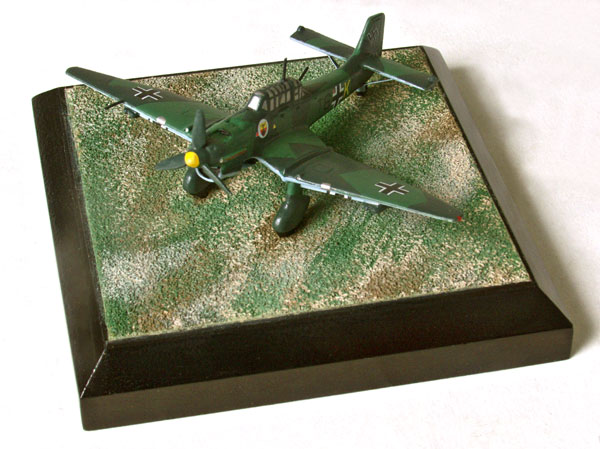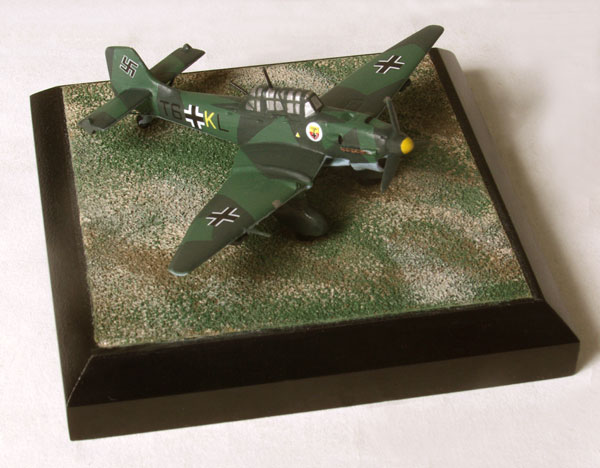Junkers Ju 87B-2 ‘Stuka’
Junkers Ju 87B-2 ‘Stuka’ T6+KL,
3./StG 2 ‘Immelman’, St Malo France, August 16th 1940
Within the rapid expansion of the Luftwaffe in the mid-1930s Ernst Udet, ex-World War I fighter pilot and now of the new Reichsluftministerium championed the establishment of a dive-bomber force. He was influenced by the development of the tactic by the United States navy as a way of delivering accurate attacks on small moving targets such as ships, and which could be applied in close and accurate support of an advancing army. The role came to be exemplified by the Junkers Ju 87B series, which became widely known by the abbreviation Stuka; its steeply diving attack, reinforced by the screaming of its undercarriage-mounted sirens, became familiar because of its well-publicised part in the successful Blitzkreig invasion of Poland in September 1939. The type and its tactics were also widely used in the May 1940 assault on France and the Low Countries, but fared less well when flown against Britain later that summer in conditions when the Luftwaffe’s air superiority no longer existed.
The Stukas’ first mission against England, as a prelude to the Battle of Britain, was an attack on Portland naval base on 4th July 1940, when against a target with no air cover available they were able to sink HMS Foylebank, an auxiliary anti-aircraft ship, with the loss of 176 lives, probably one of the greatest single losses of military personnel in an air attack on the British Isles. As well as attacks on shipping in the English Channel, the Stuka Gruppen became involved in the campaign to destroy the RAF fighters on their bases, and on 16 August the third raid of that day with over one hundred aircraft, led by Stukas of I. and III./Stg 2 and including Bf 109E escorts from II./JG 2, carried out a midday attack on the South Coast, with the principal objective the Fighter Command station of Tangmere. While some Ju 87s were detached to attack the Chain Home radar installation at Ventnor and some to the naval air station at Lee-on-Solent, but the main force struck Tangmere; two hangars were totally destroyed and the other three seriously damaged. The Station Workshops, Sick Quarters and Officers’ mess were ruined, and water and power services and Tannoy put out of action. An air raid shelter received a direct hit with thirteen killed and twenty injured; two Spitfires and seven Hurricanes were destroyed or damaged, and the six Blenheims of the nocturnal Fighter Interception Unit were lost, though fortunately the RAF’s sole Beaufighter night fighter was undamaged.
The resident 43 Squadron, which shared the airfield with similarly-equipped 1 and 601 Squadrons and the Spitfires of 602 – lost two of its Hurricanes and had a third damaged, but shot down seven 87s including three of I./StG 2; one of these may well have been T6+KL, which crash-landed at Bowley Farm, South Mundham in Sussex about five miles south-west of the airfield. As well as the T6 unit identifier it carried the unit badge, the arms of the city of Breslau where the Geschwader was stationed in 1937.
18th August was the last day of Stuka operations in the Battle of Britain; losing seventeen 87s on that day they were withdrawn from the main attack on England, and withdrawn to the Pas de Calais area, from where they undertook infrequent attacks on shipping; but their work in Western Europe was done
Scale 1:144 Wingspan 3.77″ (96 mm)
Base size 4″ (100 mm) square (No. 2)
Weight not including base 2 ozs (56 grams)
Limited edition of 25



